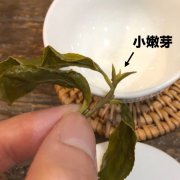Taiwan tea No. 18 Hongyu black tea introduces the price of Taiwan's top red jade black tea? how to make it good?
Taiwan tea No. 18, also known as Hongyu, Sun Moon Lake black tea.
Taiwan Camellia and Burmese big-leaf species Burma were selected from the local tea industry improvement field in Taiwan. After more than 50 years of breeding experiments, the selected varieties are suitable for black tea.
The water color of the tea is bright red, wearing a gold ring, emitting a touch of mint and cinnamon, with a mellow taste. Summer tea set convergence, tea entrance, there will be some slightly astringent feeling, but will gradually open and return to sweet, and will last for a period of time.

This is due to the high content of tea polyphenols, which is transformed into tea xanthamins and tea red substances after full fermentation. This charming aroma and taste, derived from the native species of Taiwan camellia, has been praised as "Taiwan red" and "Taiwan fragrance" by black tea experts, which can represent Taiwan black tea to compete with many world-famous black teas. It is a very unique variety.
Sun Moon Lake
Taicha No. 18 is produced in Sun Moon Lake, which is located in the central area of Shuishalian, which is a part of Youqi Township in Nantou County, in the western foothills of Taiwan's central mountains, western plains and mountains, it is located in the center of Nantou County, connecting to the northeast of Wenyi Fuxing Township in the north of Puli Town, Xinyi Township in the southeast and Water Conservancy Township in the southwest.
Due to the fold geomorphology and fault erosion around Riyue Lake, this area has many mountains and hills. In this area, there are 13 basins, steep slopes and subsidence areas of different sizes. Sun Moon Lake (5.4 square kilometers) is the only water storage basin in China.
Originally, Riyuetan, Toushe, Yuchi and Puli were lakes, but because this area is the subsidence area of Tertiary clay slate strata and the fault area of clay slate strata, basins of different sizes have been formed due to crustal changes involving fold subsidence.

Sun Moon Lake is the largest lake in Taiwan, composed of diamond-shaped Sun Lake and curved Moon Lake. The pottery people call it "Jinjin", which may be the earliest name of Sun Moon Lake. The word "Sun Moon Lake" was first recorded in Deng Chuanan's book in 1821, which wrote: "I don't know where the water comes from." It is about 10 miles (half a kilometer) long and 1/3 wide. The lake is red and green, so it is called Sun Moon Lake. " After the Han people took back the water and sand company, Sun Moon Lake had more names, such as Shuisha Lake, Shuishali Lake, Shuisha Haizi, Bamboo Lake, Dragon Lake and so on. At the end of the Qing Dynasty, Western missionaries came to Sun Moon Lake to share their beliefs with Taoists. They named Sun Moon Lake as "Dragon Lake", "Pearl Lake", "Ning-Isiwatan Lake" and so on.
The island on Sun Moon Lake is the settlement of the ancient Shao people. They think this is the home of Pashala, their highest level of ancestral spirit. The island is called "Lalu Island" in Shao language. In the Qing Dynasty, it was called Pearl Island, Pearl Mountain and so on. There is a saying that Thao Kunbariz Mountain and Lunlong Mountain (Thao Titabu) walk opposite to each other, with Lalu Island in the middle; it creates the image of two dragons playing with pearls, so it is called Pearl Island. During the Qing Dynasty, Westerners called it Pearl Island. During the Japanese occupation, it was called "Jade Island" and "Island in the Water". After recovering from the Japanese, it was called Guanghua Island.

After the earthquake on September 21, 1999, the Nantou County government changed its name to Lalu Island out of respect for the Thao tribe. The Riyue Lake Scenic spot is located in the geographical center of Nantou County, Taiwan, covering an area of about 9000 hectares. To the north is Yuzhi Town, to the east is Shuishe Mountain, and to the south is Provincial Highway 21 and Shuili Town. Sun Moon Lake has beautiful scenery, and today's administrative area also includes Taiwan's aboriginal cultural villages, Toushe, Checheng, Shui she, Ji Chi Shan, Shuili River and other communities.
The mountains in the scenic area are between 600m and 2000 m above sea level. Starting from the highest ridge in the east, the landscape gradually turns into undulating foothills, followed by swift rivers and endless green plains in the west. The latter is geographically part of the Puri Basin and is the only part of alpine lakes preserved.
The most popular tea in this area is Sun Moon Lake Black Tea, also known as Hongyu or Taicha No. 18.
Important Notice :
前街咖啡 FrontStreet Coffee has moved to new addredd:
FrontStreet Coffee Address: 315,Donghua East Road,GuangZhou
Tel:020 38364473
- Prev

How to make fruit tea? how to make fruit tea?
In recent years, fruit tea has become a trend, many teahouses have launched a variety of fruit tea and pearl milk tea. These mixed teas not only look great, but also taste good. Fruit tea not only has the aroma of fruit and rich vitamins, but also has the unique aroma and efficacy of tea. When the two are mixed, the taste matches amazingly! Excitedly, the formula of fruit tea is also
- Next

What kind of tea do winter slices belong to? what are the different flavor characteristics between winter tea and tea in each season?
According to the season in Taiwan, it is divided into spring, summer, autumn and winter. It has always been thought that the tea at the beginning of the year should be spring tea, but in some places, there may be rare winter slices after winter tea. What is a winter film? Winter slices are not the same as winter tea. Winter slices, also known as winter slices, refer to the buds that sprout after winter tea is harvested. Generally speaking, after the winter tea is harvested, the climate will enter the cold winter, and the tea tree will stop growing straight.
Related
- Beginners will see the "Coffee pull flower" guide!
- What is the difference between ice blog purified milk and ordinary milk coffee?
- Why is the Philippines the largest producer of crops in Liberia?
- For coffee extraction, should the fine powder be retained?
- How does extracted espresso fill pressed powder? How much strength does it take to press the powder?
- How to make jasmine cold extract coffee? Is the jasmine + latte good?
- Will this little toy really make the coffee taste better? How does Lily Drip affect coffee extraction?
- Will the action of slapping the filter cup also affect coffee extraction?
- What's the difference between powder-to-water ratio and powder-to-liquid ratio?
- What is the Ethiopian local species? What does it have to do with Heirloom native species?

